SIZING AND PLACEMENT
Lighting is an important element for both functionality and ambiance in any room. It can set a romantic mood or offer a bright, playful vibe. The rules of where to hang a light fixture vary from room to room and can sometimes be challenging to master. Below are a few guidelines on size and placement of table lamps, floor lamps, pendants, chandeliers and wall sconces.
LIVING ROOM
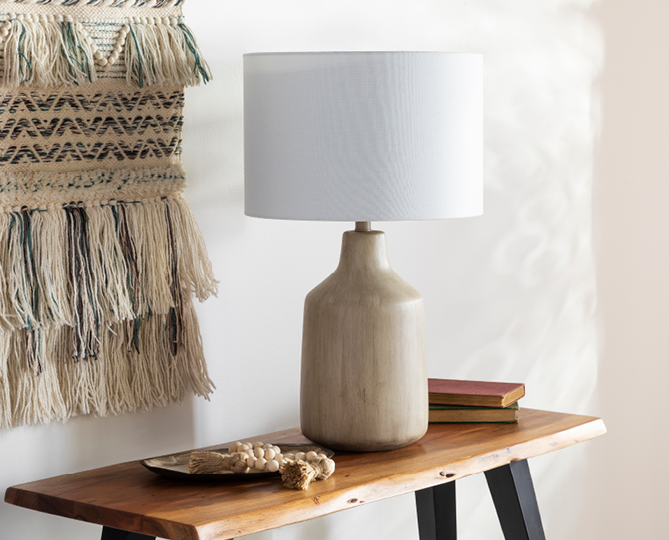
A well-lit living room should ideally include some form of layered lighting that illuminates all corners of the room to create balance. Table lamps work alongside decor to bring beauty and light to living spaces. Table lamps are generally placed on a desk, side table, buffet table or another flat surface that gives the lamp the height to softly illuminate a room. Decorating with a pair of table lamps is a popular way to create balance in a space. If a surface is too small for a table lamp, but there is still a need for an additional light source, consider a floor lamp instead. Ceiling lighting such as a dramatic chandelier or a modern pendant can also help to complete the overall look. Lastly, wall sconces are another great source of supplementary light. A popular place to hang wall sconces in the living room is on either side of the fireplace.
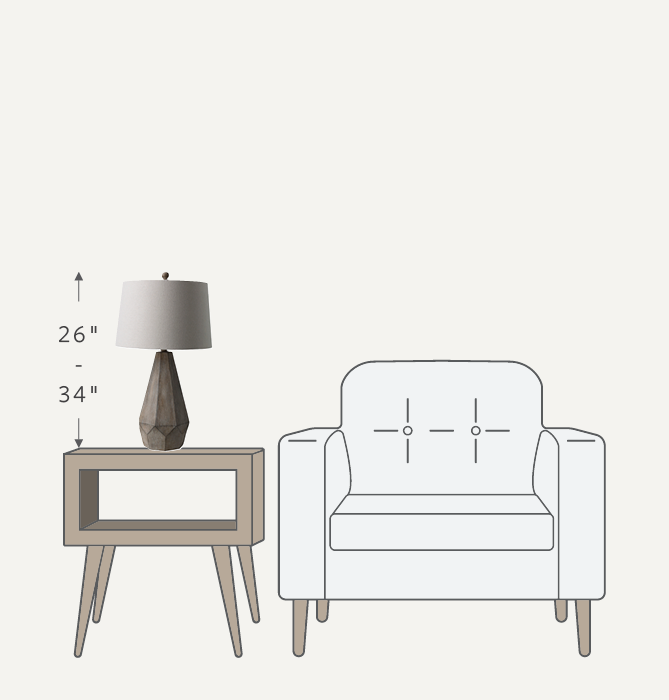
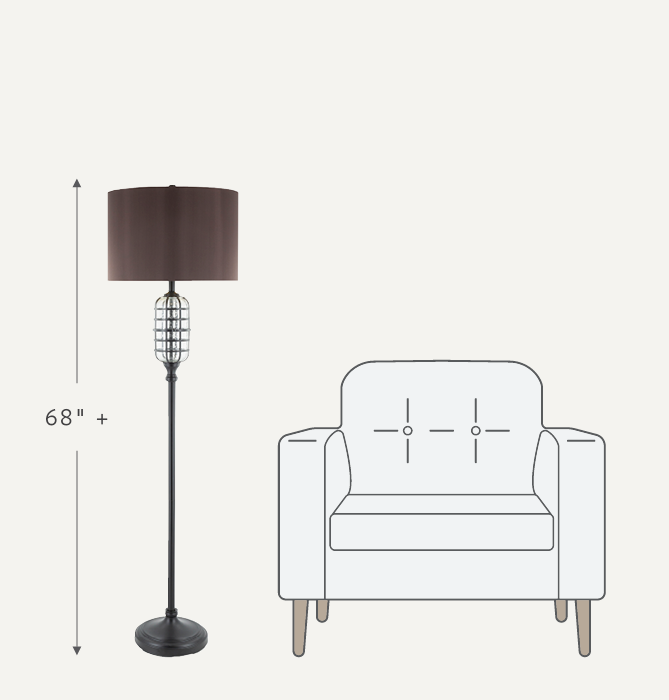
TABLE LAMP
Whether the table is set against a bare wall, beside an armchair or behind a sofa, proper placement of a table lamp ensures that the lighting will illuminate the seating area best, while also providing ambient lighting to the rest of the space. Most living rooms can accommodate table lamps that are 26 - 34 inches tall. To get the best use of the table lamp and its light source, the bottom of the shade should be right at eye level when sitting. If the side table or dedicated surface is too small for a table lamp, but there is a need for adequate reading light, consider a floor lamp.
FLOOR LAMP
The light provided by floor lamps is perfect for reducing shadows created by overhead lighting. Floor lamps near sitting areas should be approximately 68 inches high so that the shade conceals the bulb whether you are standing or sitting next to it. This placement also makes it convenient to run the electrical cord beneath a sofa or chair so it’s not an eyesore or tripping hazard.
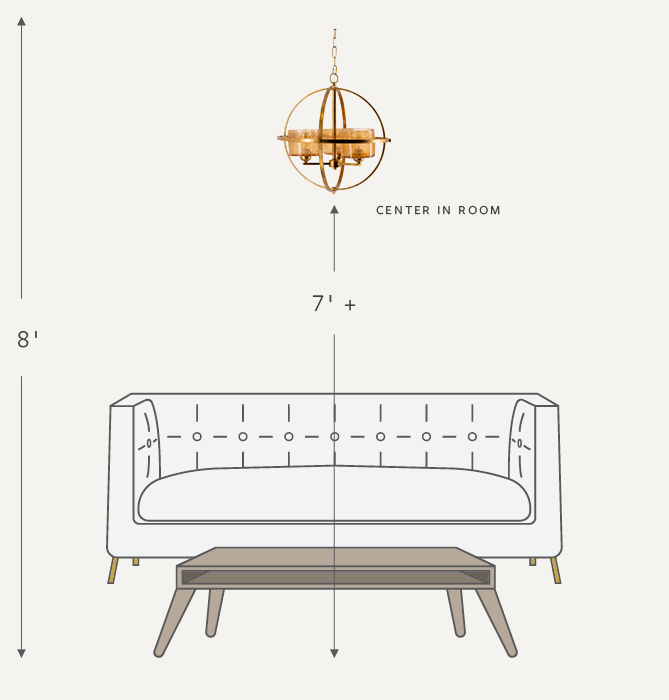
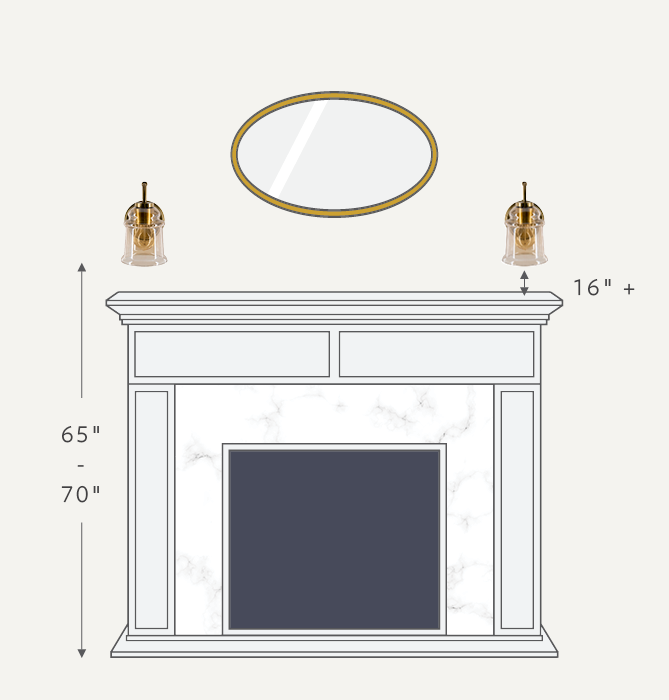
PENDANT
For optimal lighting, the pendant should be positioned in the center of the living space. For an 8 foot ceiling, leave at least 7 feet from floor to the bottom of the light fixture. For a higher ceiling, raise the light by 3 inches for each additional foot. Consider larger and taller chandeliers for ceilings 10 feet and higher. To determine the diameter of a light fixture that best suits the space, measure the length and width of the room in feet, add the two measurements together and swap that value in feet for inches – Ex: 10'L + 12'W = 22 feet so the fixture diameter should be 22 inches. Likewise, to determine the height, multiply the height of the room by 2.5" - 3" per foot – Ex: 10’ x 2.5" to 3" = 25 - 30 feet. Swap that value to inches and the ideal fixture height is 25 - 30 inches.
WALL SCONCE
Wall sconces offer a great secondary source of light in large rooms. Most living rooms have an overhead, primary light source like a chandelier, but wall sconces can be used to light up darker areas or far off corners of the room and add a flattering layer of more indirect light. Additionally, wall sconces are used in large spaces to highlight a feature in the room, such as the fireplace. Consider the mantel width from the floor to the bottom of the light fixture. Sconces should be placed approximately 60 - 72 inches from the floor to the center of the backplate. Each sconce should be placed over either end of the mantel at a minimum of 16 inches above the mantel.
DINING ROOM
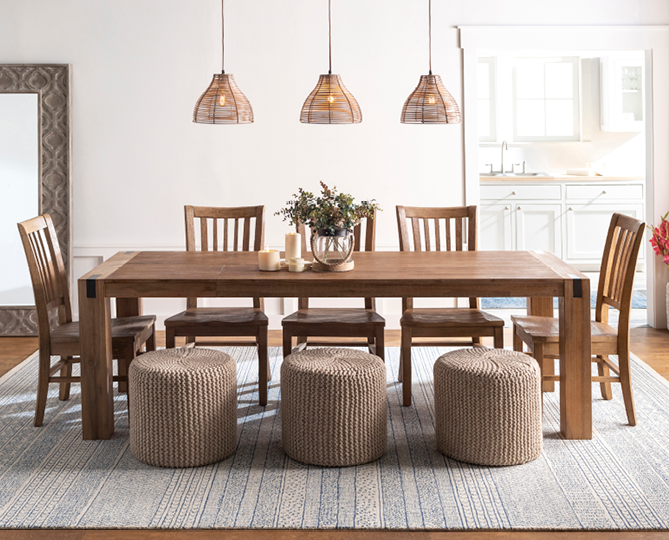
The dining room is the easiest room to light. The main light source should come from a large pendant or chandelier that is centered over the dining table. A decorative chandelier or pendant in the dining room generally offers a low level of light output and is intended to set the mood and draw the eye to the center of a room. For more functionality, consider using layers of light for a brighter ambiance.
CHANDELIER
Chandeliers should align with the size of the space and dining table. A good rule of thumb is chandeliers should have a diameter of about half to two-thirds the length of the table. For an 8 foot ceiling, leave 30 - 36 inches from the top of the dining table to the bottom of the chandelier. For higher ceilings, raise the chandelier by 3 inches for each foot.
PENDANT
For a modern lighting solution, opt for a pendant above the dining surface. Larger spaces and open-concept rooms will provide more options. Switch it up with a trio of smaller pendants for a unique look, or go with one large statement pendant for a focal point. For an 8 foot ceiling, leave 30 - 36 inches from the top of the dining table to the bottom of the chandelier. For higher ceilings, raise the pendant by 3 inches for each foot. For 3 or more pendants spacing should be at least 30 inches apart, equidistant from the center of the table.
KITCHEN
The key to good kitchen lighting is to rely on an ensemble of lighting sources and to layer lighting, mixing overall ambient light with task or accent lighting. The main source should come from a large, pendant light or several pendant lights grouped together, centered over the kitchen table. This is a great way to provide task lighting while serving as visual and design focal points.
SINGLE OR MULTIPLE PENDANTS
Single pendants and multiple smaller pendants are commonly used to provide ambient and task lighting over a kitchen island or work surface. For an 8 foot ceiling, leave 30 - 36 inches from the top of the island to the bottom of the pendant. For higher ceilings, raise the pendant by 3 inches for each foot. For 3 or more pendants spacing should be at least 30 inches apart, equidistant from the center of the island.
BEDROOM
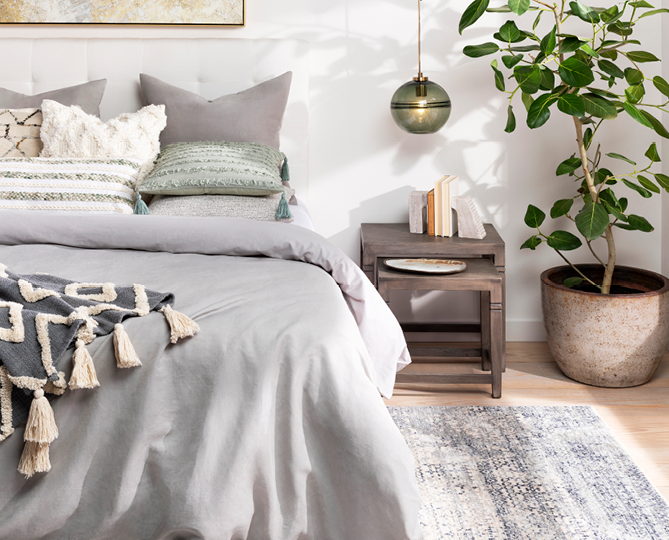
Several light sources can be used in the bedroom. Try ceiling lights for overall ambient lighting or reading, and table or floor lamps for added task lighting. Wall sconces or smaller pendants also provide a great alternative to bedside lamps. They free up surface space and provide a balanced focus.
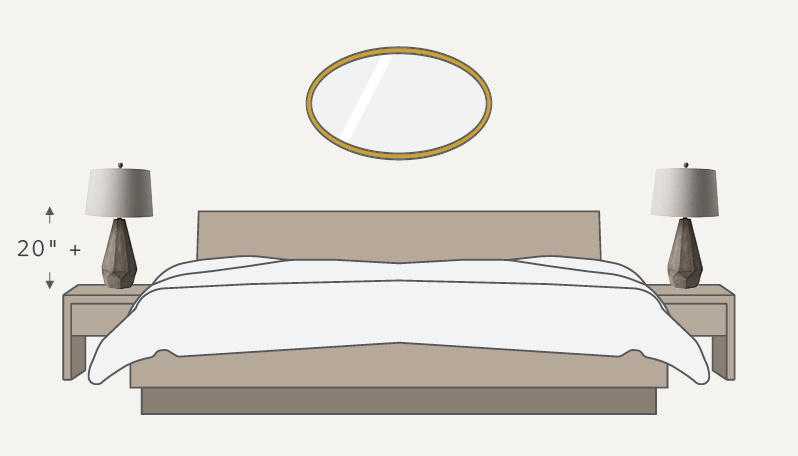
TABLE LAMP
It is best to place a table lamp closer to you or towards the back of the nightstand. This will help give you enough space to place other objects on the nightstand and the light will still illuminate the task and the room as needed. When laying down, the bottom of the table lamp shade should be at least 20 inches high from the surface to get the best use out of the light while using in bed. Assuming that the nightstand is the same height as the mattress, the ideal bedside lamp should be the same height as the nightstand plus an extra two or three inches. So, if the nightstand is 24 inches high, a lamp that is around 27 inches tall will look best.
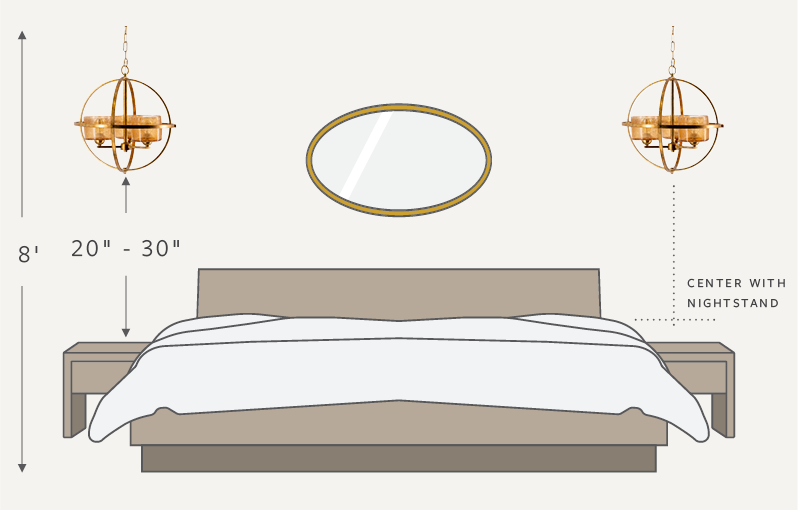
PENDANT
Pendant lighting can be hung on either side of the bed and used as an alternative to a bedside table lamp or wall sconce. It can even be positioned over the foot of the bed (as long as the light fixture is hung high enough that you can avoid hitting it when you get in and out of the bed). Place pendants on either side of the bed 20 – 30 inches from nightstand surface to fixture base, comfortably centered above nightstand and close enough that the switch can be easily accessed.
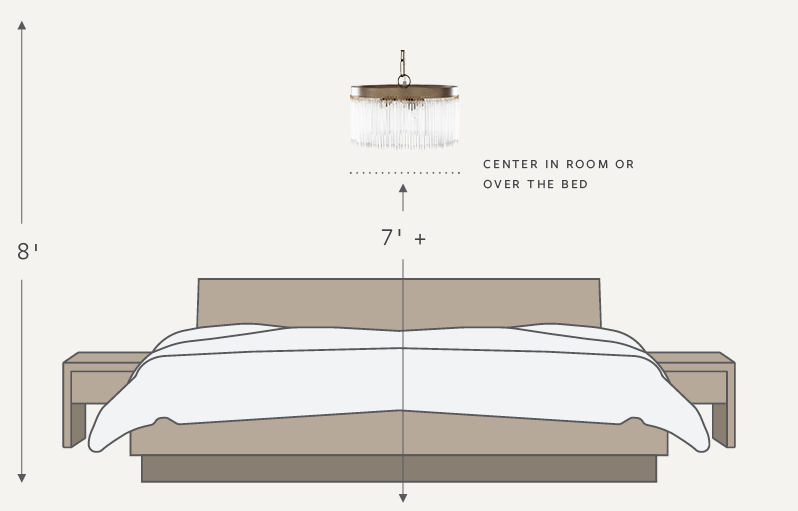
CHANDELIER
Generally, the lower you hang the fixture, the larger it should be. For a small bedroom, keep the chandelier to no more than 20 inches in diameter. In a larger bedroom, limit the chandelier to no more than 30 inches across. It is best not to hang a chandelier directly over the head of a bed but more towards the center of the room or the lower third of the bed. For an 8 foot ceiling, leave at least 7 feet from floor to the bottom of the light fixture. If you have a higher ceiling, raise the light by 3 inches for each additional foot. Consider larger and taller chandeliers for ceilings 10 feet and higher.
ENTRYWAY/HALLWAY
Whether you pick a light fixture that makes a bold statement or something more subtle and subdued, the choice of entryway lighting sets the tone for the rest of the house. The higher the ceiling, the taller the chandelier or pendant. A standard 8 foot ceiling requires a chandelier or pendant that is 20 - 24 inches in height. A quick way to figure out the recommended fixture diameter is to add the length and the width of the room considering the sum as inches and you will have the suggested diameter of the chandelier or pendant for that space.
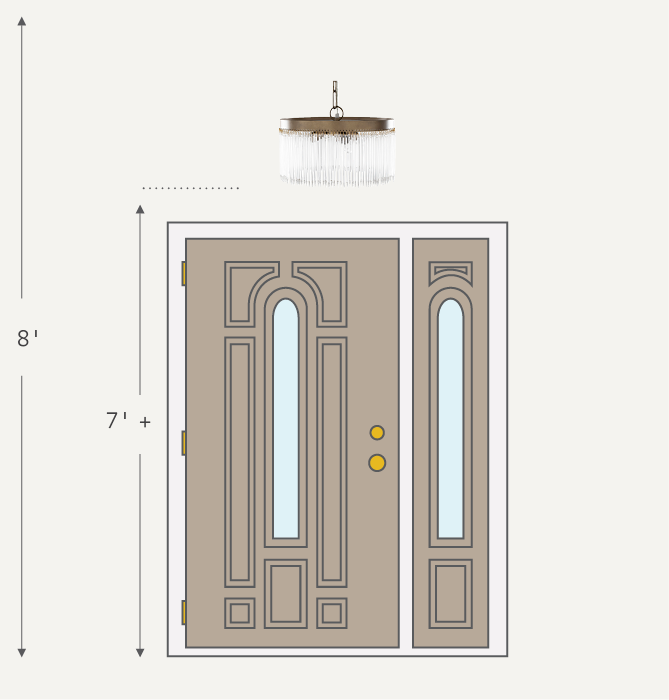
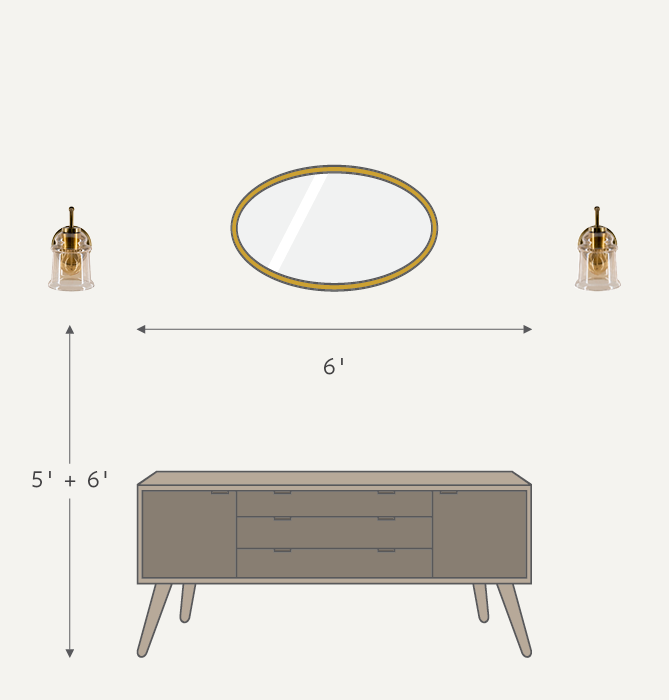
CHANDELIER/PENDANT
For an 8 foot ceiling, leave at least 7 feet from floor to the bottom of the chandelier. If you have a higher ceiling, raise the pendant by 3 inches for each additional foot. Choose a fixture that is proportional to the space of the entryway. For example, if the entryway has 75 square feet of space or more, look for a pendant or chandelier with a diameter of at least 12 - 18 inches. Smaller entryways look better with smaller chandeliers unless you want the fixture to serve as a focal point.
WALL SCONCE
Wall sconces add a welcoming glow to the entryway without taking up valuable real estate on a console table or the entryway furniture. Use one on either side of the door or an entryway system. Depending on ceiling height most wall sconces should be placed 5 - 6 feet from the floor. If placing multiples in a long hallway or on either side of wall décor, keep at least 6 feet between each wall sconce to help ensure that light fills the entire stretch with no awkward gaps.